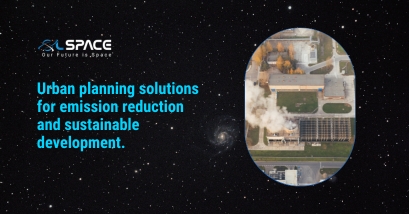29 December 2023
Urban planning solutions for emission reduction and sustainable development.

Urban areas are at the forefront of global challenges related to climate change, pollution, and unsustainable resource consumption. Effective urban planning plays a pivotal role in mitigating these issues, fostering emission reduction, and promoting sustainable development. This article explores innovative urban planning solutions that address environmental concerns, enhance quality of life, and pave the way for a sustainable and resilient future.
1. Smart Urban Mobility:
Public Transportation Optimisation: Promoting and optimising public transportation systems reduces reliance on individual vehicles, curbing emissions and alleviating traffic congestion.
Bicycle and Pedestrian Infrastructure: Developing safe and interconnected bicycle lanes and pedestrian pathways encourages eco-friendly commuting, reducing carbon emissions and promoting a healthier lifestyle.
Integration of Intelligent Transport Systems: Implementing smart technologies for traffic management, such as traffic signal optimisation and real-time route planning, enhances the efficiency of transportation networks.
2. Green Building and Infrastructure:
Energy-Efficient Building Design: Encouraging the construction of energy-efficient buildings reduces overall energy consumption and lowers carbon footprints.
Green Roofs and Urban Gardens: Integrating green roofs and urban gardens into building designs enhances insulation, mitigates the urban heat island effect, and promotes sustainable agriculture within the city.
Renewable Energy Integration: Incorporating solar panels, wind turbines, and other renewable energy sources into urban infrastructure contributes to cleaner energy production.
3. Sustainable Land Use Planning:
Mixed-Use Zoning: Implementing mixed-use zoning encourages the development of compact, walkable neighborhoods, reducing the need for extensive commutes and fostering a sense of community.
Preservation of Green Spaces: Protecting and expanding urban green spaces contributes to biodiversity, improves air quality, and provides recreational areas for residents.
Brownfield Redevelopment: Transforming former industrial sites (brownfields) into sustainable, mixed-use developments revitalises urban areas while minimising the environmental impact of new constructions.
4. Intelligent Waste Management:
Waste-to-Energy Solutions: Implementing waste-to-energy technologies converts urban waste into usable energy, reducing reliance on traditional energy sources and minimising landfill usage.
Smart Recycling Initiatives: Deploying smart bins, automated sorting systems, and incentivised recycling programs encourages responsible waste disposal practices among residents.
5. Climate-Responsive Urban Design:
Resilient Infrastructure: Designing infrastructure that can withstand the impacts of climate change, such as rising sea levels and extreme weather events, ensures long-term sustainability.
Green Corridors: Creating green corridors and permeable surfaces aids in stormwater management, prevents flooding, and enhances the overall resilience of urban areas.
Climate-Adaptive Architecture: Constructing buildings with climate-adaptive features, such as natural ventilation and shading, minimises the reliance on energy-intensive cooling and heating systems.
6. Digital Urban Planning Solutions:
Geospatial Analysis: Utilising geospatial data for urban planning enables precise mapping of emissions, air quality, and energy consumption, facilitating informed decision-making.
Urban Simulation Models: Implementing simulation models helps urban planners visualise the potential impact of development scenarios on emissions, allowing for the optimisation of sustainable solutions.
7. Community Engagement and Education:
Public Awareness Campaigns: Raising awareness about sustainable practices and the environmental impact of individual choices fosters a culture of eco-consciousness.
Community Participation in Planning: Involving residents in the urban planning process ensures that solutions align with the community’s needs and values, enhancing the likelihood of successful implementation.
8. Circular Economy Initiatives:
Resource Efficiency Programs: Implementing circular economy principles encourages the recycling and reuse of materials, minimising waste and reducing the demand for raw resources.
Localised Production and Consumption: Promoting local production and consumption reduces the environmental impact of long-distance transportation and supports regional economies.
9. Technological Innovation for Emission Monitoring:
Air Quality Monitoring Systems: Deploying advanced air quality monitoring systems allows for real-time tracking of pollutant levels, enabling prompt responses to mitigate environmental risks.
Emission-Tracking Technologies: Integrating technologies like IoT sensors on vehicles and industries helps monitor and manage emissions, fostering accountability and driving emission reduction efforts.
10. Policy Integration and Collaboration:
Interdisciplinary Collaboration: Fostering collaboration between urban planners, environmental scientists, policymakers, and communities ensures a holistic and effective approach to sustainable urban development.
Incentive-Based Policies: Implementing policies that incentivise sustainable practices, such as tax breaks for eco-friendly developments or businesses, encourages a shift towards more sustainable urban living.
Conclusion: Shaping Resilient and Sustainable Urban Futures
As urban populations continue to grow, the importance of implementing innovative and sustainable urban planning solutions becomes increasingly critical. The integration of smart technologies, eco-friendly infrastructure, and community engagement paves the way for resilient, livable cities that prioritise environmental conservation and the well-being of their inhabitants. Through a combination of forward-thinking policies, technological advancements, and collaborative efforts, urban planners can contribute significantly to emission reduction and the creation of sustainable, thriving urban environments.
